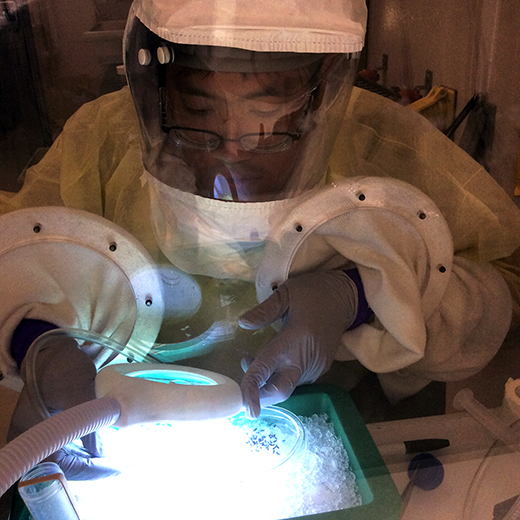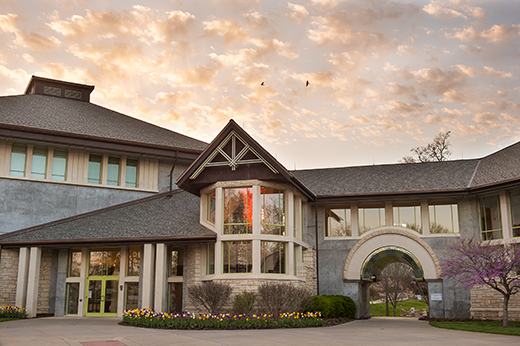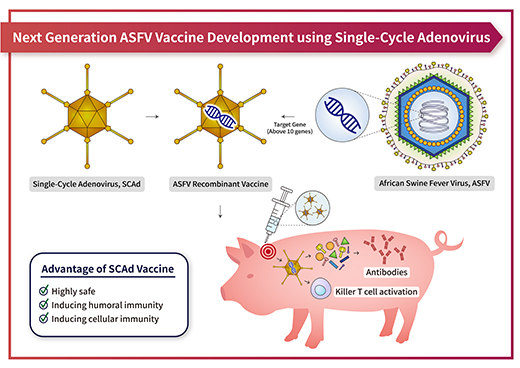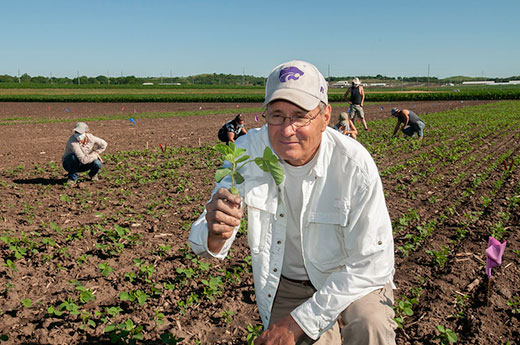07/22/20
K-State Current - July 22, 2020
K-State Current is a weekly news update for the Kansas Board of Regents to apprise the Regents on a few of the many successes and achievements made by K-State faculty, staff and students.
K-State News
Visit K-State’s “We Are #KStateStrong” site to view brief videos designed to keep the K-State family engaged, connected and inspired during these challenging times.
K-State study first to show SARS-CoV-2, which causes COVID-19, not transmitted by mosquitoes

A study at the Kansas State University Biosecurity Research Institute is the first to confirm that SARS-CoV-2 cannot be transmitted to people by mosquitoes. The study has been published by Nature Scientific Reports.
A new study by Kansas State University researchers is the first to confirm that SARS-CoV-2 cannot be transmitted to people by mosquitoes.
Stephen Higgs, associate vice president for research and director of the university's Biosecurity Research Institute, or BRI, together with colleagues from the BRI and the College of Veterinary Medicine had the findings published July 17 by Nature Scientific Reports.
The article, "SARS-CoV-2 failure to infect or replicate in mosquitoes: an extreme challenge," details the study's findings, which provide the first experimental investigation on the capacity of SARS-CoV-2, the virus that causes COVID-19 disease, to infect and be transmitted by mosquitoes.
"While the World Health Organization has definitively stated that mosquitoes cannot transmit the virus, our study is the first to provide conclusive data supporting the theory," said Higgs, Peine professor of biosecurity and university distinguished professor of diagnostic medicine and pathobiology.
The study, which was done at the BRI, a biosafety level-3 facility, ultimately found that the virus is unable to replicate in three common and widely distributed species of mosquitoes — Aedes aegypti, Aedes albopictus and Culex quinquefasciatus — and therefore cannot be transmitted to humans.
"I am proud of the work we are doing at K-State to learn as much as we can about this and other dangerous pathogens," said Higgs. "This work was possible because of the unique capabilities of the BRI and the dedicated BRI and institutional staff."
Colleagues involved with the study include Yan-Jang Huang, research assistant professor of diagnostic medicine and pathobiology; Dana Vanlandingham, professor of diagnostic medicine and pathobiology; Ashley Bilyeu and Haelea Sharp, research assistants in diagnostic medicine and pathobiology; and Susan Hettenbach, research assistant at the BRI.
Researchers at the BRI have completed four additional studies on COVID-19 since March and this is the first peer-reviewed publication based on SARS-CoV-2 experiments wholly conducted at K-State.
Research at the Biosecurity Research Institute has been ongoing with other animal pathogens that can be transmitted from animals to people, including Rift Valley fever and Japanese encephalitis, as well as diseases that could devastate America's food supply, such as African swine fever and classical swine fever. The research was in part supported by the National Bio and Agro-Defense Facility Transition Fund provided by the state of Kansas.
"We have remarkable talent and capabilities working within our research and training facility at the BRI," said Peter Dorhout, K-State vice president for research. "The BRI is one of the critical anchor facilities in the North Campus Corridor, which serves as our growing research and development space for private sector and government agency partnerships with K-State."
College of Education study finds top challenges of Kansas K-12 teachers in COVID-19 crisis
 A survey of K-12 teachers in Kansas during the COVID-19 pandemic by a multidisciplinary research team from the Kansas State University College of Education looked at four key areas: technology/access; student/parent engagement; educator resiliency; and social-emotional well-being.
A survey of K-12 teachers in Kansas during the COVID-19 pandemic by a multidisciplinary research team from the Kansas State University College of Education looked at four key areas: technology/access; student/parent engagement; educator resiliency; and social-emotional well-being.
A survey by a multidisciplinary team of researchers at the Kansas State University College of Education has identified the top needs and challenges of K-12 teachers during the COVID-19 pandemic.
More than 800 teachers in rural, urban and suburban school districts across the state participated in the project, "Access, Engagement and Resilience During COVID-19 Remote Learning." Questions centered on four key areas: technology/access; student/parent engagement; educator resiliency; and social-emotional well-being.
The purpose of the study was to identify meaningful data for district administrators and policymakers for school reopening while informing K-State's teacher preparation program. The survey was sent in May, about two months into the pandemic.
Debbie Mercer, dean of the K-State College of Education, noted Kansas schools were the first in the nation to announce closure due to the pandemic, which opened the door for substantive inquiry.
"Ten days. That's how much time teachers and administrators had to move our state's half-million students to online instruction," Mercer said. "At the same time this immense transition was occurring, teachers themselves were dealing with uncertainties in their personal lives. Bottom line? Teachers need support."
The findings revealed a myriad of strengths and weaknesses and identified universal needs for students' social-emotional well-being, which was the teachers' top concern; broadband access, which was deemed a dire need by teachers; educator well-being; and strengthening engagement in diverse learning environments.
The survey revealed several bright spots, particularly in the area of engagement:
- Teachers reported that 69% of students were considered highly to somewhat engaged in learning.
- Among rural teachers, 36% reported a higher level of engagement with their students, while 27% of all teachers reported that their personal engagement with students had increased.
- Nearly two-thirds — 64% —of educators reported an increase in personal engagement with parents during the pandemic.
But in the social-emotional well-being and technology and access areas, the survey revealed some serious challenges.
Four out of 5 teachers — 82% — listed social-emotional well-being as their highest concern, and this was across all school classifications, from 1A to 6A, and in rural, suburban and urban districts.
"I fear a mental health crisis is coming,” said Jessica Lane, a member of the research team and an assistant professor of special education, counseling and student affairs. "The survey results give voice to the experiences of Kansas educators and underscore the need going forward for policymakers and administrators to address the mental health and social-emotional well-being of both our students and educators. It is critical."
Lane's conclusion is particularly striking when the teachers' personal situations were addressed. Survey findings include:
• Two-thirds — 66% — of suburban and urban teachers were simultaneously serving as caregivers to either their children, other adults or the elderly. For rural educators, this number rose to 4 in 5, or 79%.
- Some economic insecurity was experienced by 36% of teachers.
- About 20% of responding educators faced food insecurity.
The shift to remote instruction revealed significant inequities concerning technology and access to the internet. The survey found that broadband and educational technology are not consistently available in Kansas, and when they are, that did not translate into in-home access. This required teachers and districts to provide varied forms of instruction.
Nearly 70% of teachers indicated their districts worked with local internet providers to coordinate reduced cost or even free internet. Nearly 50% reported their districts provided hot spots or worked with community partnerships to ensure access for their students.
Nearly two-thirds of respondents — 65% — used technology to provide continuous learning opportunities, while 30% reported the use of take-home packets for students and 5% listed other means of instruction.
In addition to Lane, the other members of the multidisciplinary research team included Laura Bonella, associate professor at K-State Libraries; Doris Wright Carroll, associate professor of special education, counseling and student affairs; Morgan Jobe, program coordinator; Marilyn Kaff, associate professor of special education, counseling and student affairs; Tonnie Martinez, assistant professor of curriculum and instruction; Leah McKeeman, assistant professor of curriculum and instruction; and Cindy Shuman, associate dean for research.
Beach Museum of Art offers online interactive tools for fun and thought-provoking art experiences
 The Marianna Kistler Beach Museum of Art at Kansas State University may be closed for the time being, but the museum's collections and new programming are accessible thanks to online interactive tools that are free to all.
The Marianna Kistler Beach Museum of Art at Kansas State University may be closed for the time being, but the museum's collections and new programming are accessible thanks to online interactive tools that are free to all.
"Museum staff members have been hard at work on these tools and programming since the Beach Museum of Art was closed indefinitely because of COVID-19," said Linda Duke, director. "We hope everyone, including children and families, will enjoy visiting the museum virtually and often."
Here are some ways to enjoy the Beach Museum of Art online:
- "Let's Talk Art" is a new livestreamed conversation series with artists and others. The first is set for 5:30 p.m. CDT Thursday, July 9, with Norman Akers, artist and associate professor of art at the University Kansas. Registration is required for this free program so that audience numbers can be counted and is available at ksu.zoom.us/meeting/register/tJ0ucOitqDgoGt2LXXTDeWKq3yS4g31X9FYb. After registering, participants will receive a confirmation email with information about how to join the program.
- The Beach Museum of Art's current exhibition, "Voices of the West," curated by Elizabeth Seaton, is now available to view online. It includes many never-before-displayed works from the museum's collection, some by regional Native American artists. View the online exhibition in a PDF format at beach.k-state.edu/documents/OnlineExhibition_Voices_of_the_West_2020_MKBMA.pdf.
- The museum has a number of educational resources for schools, early childhood programs, social service organizations and home school groups. Find the details at beach.k-state.edu/participate/educational-resources/.
- Join the Beach Buddies Facebook group to find resources and activities for children, families and educators. To join, go to facebook.com/groups/557851618472026/about/.
- The museum's YouTube channel features videos of art, artists, and special programs. Enjoy the videos at youtube.com/channel/UC1obT2UdtQU6U0j0uz2gJzQ.
- Use the free app Smartify to view 2D and 3D artworks in the museum's galleries. Smartify instantly returns text, audio and video interpretation. The app, for Apple and Android devices, can be downloaded from the Apple Store or Google Play Store. To use from home, click on the Explore tool to search for the Marianna Kistler Beach Museum of Art and its gallery offerings and to gain access to works in other museums. Take advantage of the app's personal gallery making tool.
- Thinking about Pictures, or TAP, is the museum's newest tool. TAP offers images of artworks in the museum's current exhibition "Inspirations: Art for Storytelling." Users can choose an image and then challenge themselves to type in their observations and interpretations. The app allows users to return often to respond to other images. Duke said the app can be used as an intergenerational activity. "If a young person cannot yet type in responses, an older child or adult can serve as the scribe," she said. Start exploring TAP at kstate.qualtrics.com/jfe/form/SV_1ZaF06qpsMInLeZ.
- To explore, research or enjoy the Beach Museum of Art's collection of nearly 10,000 objects, use Verandah, the museum's collection search tool. Learn more about Verandah at beach.k-state.edu/explore/collection/.
- Find fun interactive posts about regional art and artists on the Beach Museum of Art on its social media channels. Enjoy and share often on Facebook, /BeachMuseumofArt; Instagram, /beachmuseum; and Twitter, @BeachMuseum.
More tools and offerings will be added soon, so Duke said to check out the museum's website frequently, beach.k-state.edu, to learn more. New offerings will soon include a cloud-based collection management system and online search tool called The Museum System and more online viewings of past and current exhibitions.
K-State Faculty Highlights
Veterinary researcher works with South Korean company on African swine fever virus vaccine development
 An illustration of the development of a next-generation African swine fever virus vaccine using single-cycle Adenovirus. The work is taking place at Kansas State University.
An illustration of the development of a next-generation African swine fever virus vaccine using single-cycle Adenovirus. The work is taking place at Kansas State University.
New vaccine development work at Kansas State University may soon help confront African swine fever, a disease that is endemic in sub-Saharan Africa. It has spread to different regions of Europe and Asia, causing devastating losses worth billions of dollars in China, Vietnam and other surrounding countries where pork is the most popular food item.
K-State is doing the vaccine development work through a sponsored research agreement facilitated by K-State Innovation Partners and MEDIAN Diagnostics Inc., or MDx, a veterinary medicine company based in South Korea. K-State Innovation Partners facilitates technology commercialization for the university.
"The technology we are utilizing is based on a novel adenovirus backbone — developed from human adenovirus serotype 6 — that can amplify a transgene up to 10,000 copies in the infected cell without producing infectious viruses," said Waithaka Mwangi, professor of diagnostic medicine and pathobiology in the university's College of Veterinary Medicine.
Mwangi said the technology of single-cycle adenovirus, or SCAd, allows a recombinant virus encoding a gene of interest to mediate protein expression in an infected cell in a similar manner as a replication competent virus but without producing infectious progeny — making it safe to use. This platform was originally developed at the Mayo Clinic.
"We believe this will be a way to deliver a safe and effective vaccine," Mwangi said.
Mwangi said that the single-cycle adenovirus vaccine platform can safely induce more robust and persistent immune responses compared to live, inactivated and subunit vaccines that are traditionally used.
"There are a lot of issues to be solved for commercializing an African swine fever virus vaccine and one of the main problems is safety," said JinSik Oh, CEO of MDx. "We should enhance the vaccine efficacy on the basis of guaranteed safety. We are convinced the SCAd technology is one of the most advanced and promising platforms to develop next-generation African swine fever vaccine candidates and Kansas State University is the best partner to cooperate with in the veterinary research and development area, so MDx made a decision to invest in this project."
MDx expects the formulation and testing of the new African swine fever virus vaccine candidate to be completed through this research and development project, which is entering the first year of funding and will continue through 2023.
Were African swine fever to enter the U.S., where there are millions of feral pigs and ticks capable of transmitting the virus, it could cause billions of dollars in economic losses to swine and other related industries according to animal disease experts. The pork industry in China and other parts of Asia is expected to take a long time to recover from the 2018 outbreak and the virus is expected to become endemic in Europe where it has infected wild boars.
Taking the heat: K-State leads effort to develop heat stress-resilient soybeans
 Kansas State University soybean breeder Bill Schapaugh is leading a team of K-State and University of Missouri researchers who are working to develop soybean cultivars that are more resilient to heat during the critical post-flowering stage of development.
Kansas State University soybean breeder Bill Schapaugh is leading a team of K-State and University of Missouri researchers who are working to develop soybean cultivars that are more resilient to heat during the critical post-flowering stage of development.
On a recent summer morning, a team of students and scientists worked quietly, row by row in a research field, thinning soybean seedling plants by hand and saving the strongest to establish a uniform plant population for varieties to be grown in a new research project.
The team, led by Kansas State University agronomy professor and soybean breeder Bill Schapaugh, is just starting work on a three-year effort to develop soybean varieties that will better withstand heat stress in the critical post-flowering stage of development. He is working with K-State associate professor and crop physiologist Krishna Jagadish and University of Missouri geneticists Henry Nguyen and Tri Vuong on the project.
The work is made possible by a $500,000 award from the U.S. Department of Agriculture’s National Institute of Food and Agriculture (USDA-NIFA).
“The long-term goal of this research is to strengthen the development of commercial soybean varieties with improved tolerance to heat stress,” Schapaugh said, adding that the specific goal is to identify and characterize unique sources of post-flowering heat tolerance in existing soybean germplasm that can be used to develop commercial varieties.
“We are focusing on post-flowering (the seed-filling stage of development) because environmental stresses, such as heat, tend to have the largest impact on seed yield and seed composition during this period of growth,” Schapaugh said.
High daytime temperatures during that stage of soybean development can negatively impact yield – or, how much grain a plant produces – and grain quality, which ultimately reduces what farmers have available to sell after harvest.
That’s particularly important because climate models are projecting that U.S. soybean growing regions will not only experience increased mean seasonal high temperatures, but also frequent episodes of high daytime temperature stress, Schapaugh said.
The researchers are laying the groundwork for developing new cultivars that can tolerate heat stress better than those currently available by accomplishing three objectives, including
- Observing different cultivars’ yield and composition changes during induced heat stress through a process called phenotyping.
- Mapping genomic regions responsible for sustaining yield, seed quality and composition under post-flowering heat stress.
- Validating haplotypes – DNA characteristics that tend to be inherited together with the goal of strengthening breeding efforts to improve soybean resilience under post-flowering heat stress in the future.
To control how much heat and other environmental factors some of the plants are subjected to, the team will grow part of the soybean accessions in eight large tents. Others will be grown outdoors.
The heat tents are unique, custom designed structures placed over the plots that are covered with a clear polyethylene film, Schapaugh said. They resemble a clear wall tent. Air inside the tents will be heated from the sunlight and sensors, and electrically-controlled panels regulate the temperature within the tents during the day. Such heat tents have not been used routinely in soybean research but have been used in a similar manner by Jagadish’s team to examine heat tolerance in wheat.
As part of the research team, K-State and MU undergraduate and graduate students, plus a post-doctoral researcher are enhancing their own education and research skills and techniques, Schapaugh said.
In the end, he added, consumers will benefit from a more consistent supply and quality of soybean products.
More information about K-State’s Department of Agronomy is available online or by calling 785-532-6101.
